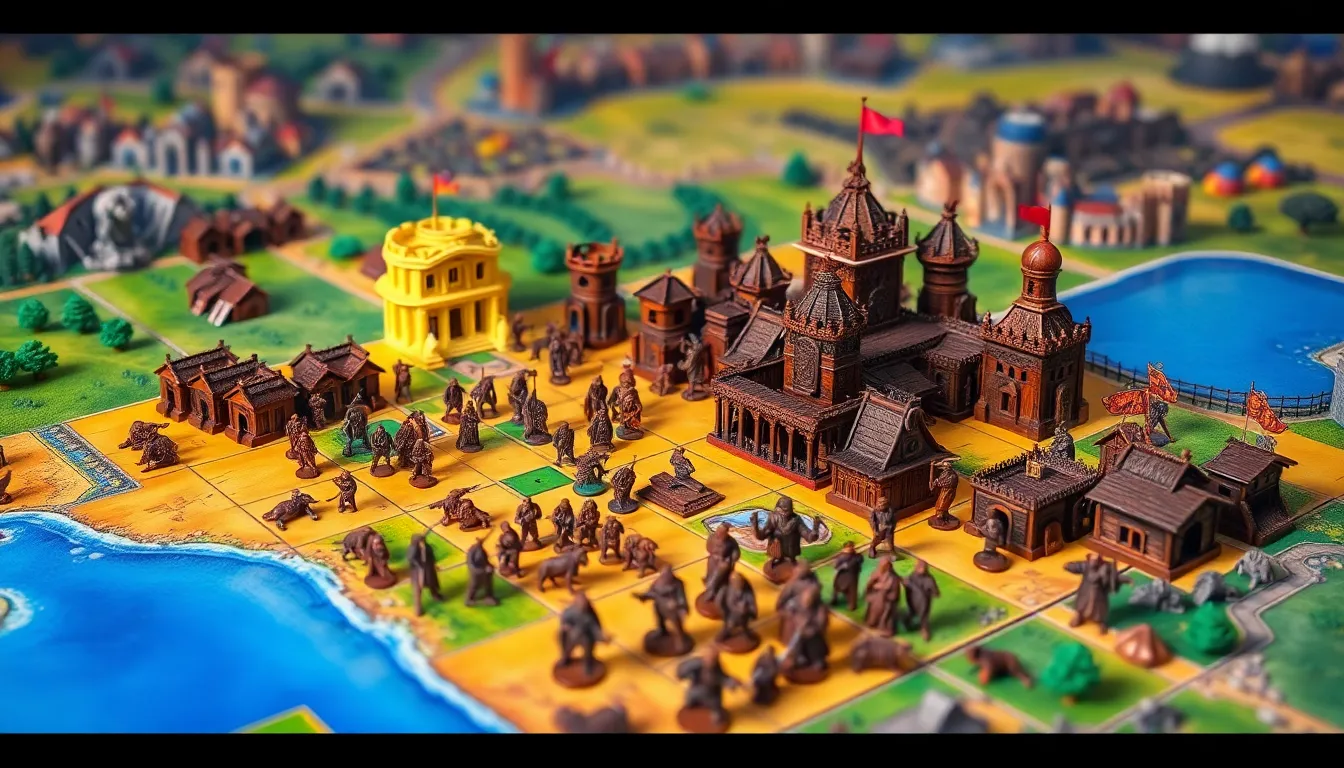In the world of real-time strategy games, Age of Empires stands out for its rich historical contexts and diverse civilizations. Each civilization offers unique strengths, weaknesses, and playstyles that can significantly impact a player’s strategy. Understanding these nuances is crucial for anyone looking to dominate the battlefield and build a thriving empire.
This guide delves into the intricacies of each civilization, providing insights into their unique units, technologies, and strategies. Whether players prefer a fast-paced offensive approach or a more defensive, resource-focused game plan, knowing how to leverage a civilization’s strengths can make all the difference. Get ready to explore the fascinating world of Age of Empires and elevate your gameplay to new heights.
Table of Contents
ToggleOverview of Age of Empires
Age of Empires is a renowned real-time strategy game series that immerses players in historical epochs, from ancient civilizations to the early modern era. Players manage economies, gather resources, and build armies, all while competing against opponents. Each civilization within the game has specific attributes that impact gameplay, such as unique units, technologies, and architectural styles.
The civilizations are categorized by their distinct advantages. Some civilizations, for instance, excel in military strength, providing players with advanced units and combat bonuses. Others focus on economic efficiency, allowing for faster resource gathering and production. Understanding these strengths and weaknesses is crucial for developing effective strategies.
Players can choose between different approaches. Offensive strategies leverage military power and aggressive tactics, while defensive strategies prioritize fortifications and resource management. Mastering the unique technologies and units available to each civilization allows players to tailor their strategies to match their preferred playstyle and adapt to the dynamics of each match.
Age of Empires encourages exploration of not just gameplay mechanics but also the historical contexts that inspire the various civilizations. Each civilization reflects unique cultures and histories, providing layers of depth and engagement in the gameplay experience. By understanding these elements, players can efficiently navigate the complexities of the game and improve their competitiveness on the battlefield.
Importance of Choosing the Right Civilization

Selecting the appropriate civilization in Age of Empires significantly influences a player’s strategy and overall success. Understanding the unique attributes of each civilization allows players to align their tactics with their strengths and weaknesses.
Factors to Consider
- Strengths and Weaknesses
Evaluating a civilization’s inherent strengths and weaknesses is crucial. Some civilizations excel in military capabilities, while others offer enhanced economic advantages. For instance, the Aztecs possess powerful infantry units, whereas the British benefit from faster-growing economies.
- Unique Units
Analyzing the unique units of each civilization enhances tactical decisions. Unique units often provide advantages in specific scenarios. For instance, the Franks feature strong cavalry units, making them formidable in rapid assaults.
- Technological Advancements
Considering the technologies available for each civilization can dictate a player’s development path. Civilizations with advanced technologies, such as the Byzantines, can significantly bolster defenses and economy.
- Resource Management
Understanding resource management capabilities is essential. Civilizations that gather resources more efficiently allow for faster advancements, enabling players to build stronger armies quicker. For instance, the Chinese civilization receives additional resources at the beginning, facilitating initial growth.
Playstyle Implications
- Offensive vs. Defensive
Evaluating whether a civilization supports an offensive or defensive playstyle helps in formulating strategies. Offensive civilizations, like the Huns, thrive on quick attacks, while defensive civilizations, like the Italians, emphasize fortifications and prolonged engagements.
- Game Phases
Recognizing a civilization’s strengths during specific game phases, such as the early game or late game, is critical. Some civilizations, like the Goths, excel in the late game with strong infantry, while others might be more vulnerable.
- Adaptability
Assessing adaptability based on civilization features can influence overall performance. Civilizations that can shift strategies effectively, like the Spanish, which have versatile units, tend to outmaneuver opponents.
- Synergy with Allies
Understanding how a civilization’s strengths complement allies can enhance team strategies. Choosing civilizations that provide supporting roles can lead to more effective teamwork in multiplayer modes. For example, pairing a militaristic civilization with an economically strong ally maximizes overall team efficiency.
Choosing the right civilization empowers players to exploit their chosen strategies effectively and enhances competitive gameplay.
Detailed Civilization Profiles
Exploring detailed profiles of civilizations in Age of Empires reveals their unique strengths and playstyles. Understanding these characteristics helps players strategize effectively.
Civilization 1: Aztecs
- Unique Units: Aztecs feature the Jaguar Warrior, a strong infantry unit with high health and attack power. They excel in close combat.
- Strengths: They benefit from stronger infantry and faster gathering rates for resources. Their economy thrives on food production.
- Weaknesses: Limited cavalry options can hinder mobility. Reliance on infantry may lead to vulnerabilities against advanced ranged units.
- Technologies: Aztecs receive bonuses such as increased damage for infantry and unique technologies that enhance resource gathering.
Civilization 2: British
- Unique Units: The British utilize the Longbowman, an archery unit with extended range and improved accuracy. They dominate in ranged combat.
- Strengths: Their civilization specializes in farming efficiency and has superior economic advantages. They progress quickly through the ages.
- Weaknesses: Deficient in siege weaponry can limit their ability to break through fortified positions. They may struggle in early rush scenarios.
- Technologies: The British have technologies that enhance archery range bonuses and improve resource gathering from farms.
Civilization 3: Mongols
- Unique Units: Mongols bring the Mangudai, a versatile mounted archer capable of hit-and-run tactics. They excel in mobility and harassment.
- Strengths: Their cavalry units gain speed bonuses, allowing for rapid troop movement. They gather food from hunts more effectively.
- Weaknesses: Their infantry units lack strength compared to other civilizations. A heavy reliance on cavalry can lead to vulnerabilities against anti-cavalry units.
- Technologies: Mongol technologies improve cavalry efficiency and increase the speed of troop movement on the battlefield.
Civilization 4: Franks
- Unique Units: The Franks boast the Chivalric Knight, a powerful cavalry unit known for high health and damage. They dominate in head-on confrontations.
- Strengths: Strong economic bonuses for farms enable rapid resource collection. Their cavalry units are robust and effective in battle.
- Weaknesses: Limited ranged options can expose them to powerful archer-focused enemy strategies. They may struggle against infantry-heavy opponents.
- Technologies: Franks have technologies enhancing cavalry units and providing bonuses to farming efficiency.
Civilization 5: Chinese
- Unique Units: Chinese civilizations feature the Chu Ko Nu, a crossbowman capable of firing multiple arrows. They excel in ranged combat effectiveness.
- Strengths: Their civilization starts with additional resources but at the cost of a lower population limit initially. This enables quick development.
- Weaknesses: Units can be resource-heavy, slowing down early game progress if not managed properly. Balancing economic growth and military power can prove challenging.
- Technologies: Chinese technologies enhance crossbowmen effectiveness and strengthen overall resource management capabilities.
Civilization 6: Byzantines
- Unique Units: Byzantines have the Cataphract, a heavily armored cavalry unit featuring high durability and offensive potential. They dominate in late-game conflicts.
- Strengths: Strong defensive capabilities, particularly in building upgrades, provide added longevity. Their civilization features a robust economy.
- Weaknesses: Limited offensive options in early stages can slow strategic expansion. Dependence on defenses can lead to a reactive gameplay style.
- Technologies: Byzantine technologies improve building defenses and cavalry effectiveness, making them a formidable opponent in prolonged conflicts.
Civilization 2: Name
The second civilization presents unique traits that significantly impact gameplay. Players can leverage these aspects to formulate effective strategies.
Unique Units and Technologies
This civilization boasts distinctive units that enhance its military capabilities. For instance, the special unit is versatile, incorporating unique abilities that outmatch standard counterparts. Technologies provide distinct bonuses, improving performance in key areas, such as economy or combat. Players gain access to advanced upgrades early, allowing for impressive development throughout the game. Understanding the synergies between the unique units and technologies enables players to maximize their efficiency on the battlefield.
Strategies for Success
Adopting the right strategies is crucial for utilizing this civilization effectively. Players should focus on early expansion, capitalizing on economic advantages. Employing a mix of offensive and defensive tactics helps maintain control over resources while preparing for enemy advances. Utilizing unique units in combination with upgrades can lead to overwhelming enemy forces. Planning for late-game transitions is vital; when players deploy powerful technologies, they can dominate in critical moments. Adaptiveness in response to opponents’ strategies further enhances success, ensuring any game remains competitive and engaging.
Civilization 3: Name
Civilization 3 offers unique strengths and capabilities, significantly impacting gameplay and strategy choices. Players can utilize specific units and technologies that define their approach to the game.
Unique Units and Technologies
Civilization 3 features distinct units that provide tactical advantages. For example, the special unit enhances combat effectiveness, outperforming typical kinds in speed and damage output. Additionally, players gain access to advanced technologies that improve resource management or military strength, facilitating quicker upgrades and expansion opportunities. This civilization’s technologies prioritize efficiency, encouraging players to optimize their resource allocation and boost productivity.
Strategies for Success
Strategies for Civilization 3 center around its unique traits. Focusing on early-game resource gathering maximizes advantages, allowing for rapid development of infrastructure. Utilizing the unique unit effectively in skirmishes can disrupt enemy plans and secure crucial territory. Balancing offensive and defensive tactics proves beneficial, with coordinated attacks complementing strong positioning. Adaptability remains essential; players should adjust their strategies based on opponents’ actions and capitalize on the civilization’s technological edge for late-game transitions.
Tips for Mastering Civilizations
Mastering civilizations in Age of Empires involves strategic planning and an understanding of unique attributes. Players must assess their civilization’s strengths and weaknesses to formulate effective tactics.
Developing Effective Strategies
- Analyze Your Civilization: Examine unique units and technologies that provide advantages in specific situations.
- Adapt to Opponents: Adjust strategies based on the opponent’s civilization and playstyle for the best chance of success.
- Leverage Unique Strengths: Utilize the distinct strengths of your civilization during critical game phases to gain the upper hand.
- Prioritize Resource Management: Efficient gathering and early expansion enhance a player’s ability to advance and build formidable armies.
- Balance Offense and Defense: Incorporate a mix of aggressive and defensive strategies to control resources and manage opponent threats.
Understanding Civilization Bonuses
- Identify Bonuses: Recognize the bonuses that each civilization offers, such as improved military units or resource efficiency.
- Match Playstyle to Bonuses: Choose a playstyle that complements the civilization’s unique bonuses for optimal performance.
- Exploit Economic Benefits: Utilize economic bonuses to secure resources faster, allowing for quicker advancements and unit production.
- Capitalize on Military Strengths: Focus on the civilization’s unique military units during battles, maximizing effectiveness in skirmishes.
- Transition to Late Game: Plan for technological advancements by leveraging early bonuses to strengthen long-term strategies.
Mastering the civilizations in Age of Empires can elevate a player’s experience and effectiveness in the game. By understanding the unique characteristics of each civilization players can make informed decisions that align with their preferred strategies. Whether focusing on military strength or economic efficiency the right choice can provide a significant advantage.
Players should remain adaptable and leverage their civilization’s strengths while also considering their opponents’ strategies. This approach not only enhances gameplay but also fosters a deeper appreciation for the rich historical context that Age of Empires offers. With the right knowledge and strategies players can truly thrive in this immersive and competitive environment.




